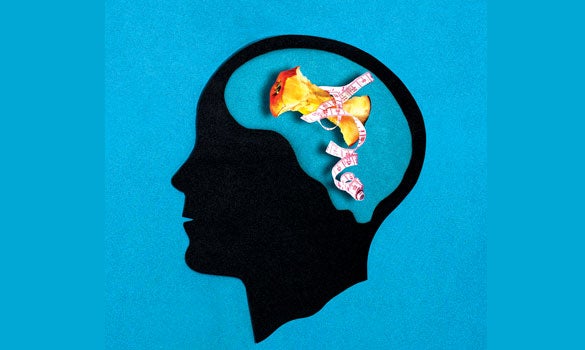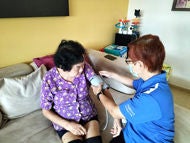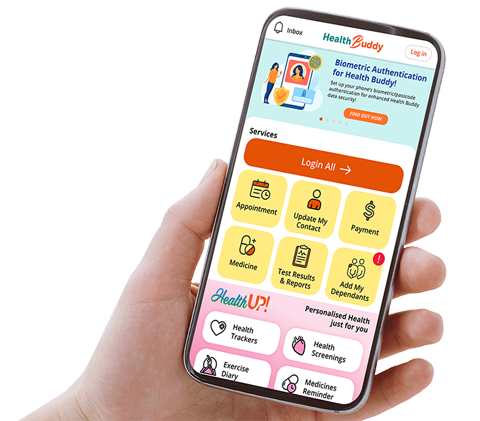
Eating disorders are complex illnesses that have a significant impact on the bio-psychosocial health of the patient. Despite the medical complications and relatively high prevalence, eating disorders are not referred early for effective treatment due to the lack of specificity of the initial presentation and the range of clinical presentation.
 As eating disorders commonly develop in adolescence, the impact on health is more significant, and early recognition and treatment is needed. Anorexia nervosa (AN), bulimia nervosa (BN) and binge eating disorders (BED) have a median age of onset from 12 to 13 years old; and a median age of onset of 11 years old for avoidant-restrictive food intake disorder (ARFID).
As eating disorders commonly develop in adolescence, the impact on health is more significant, and early recognition and treatment is needed. Anorexia nervosa (AN), bulimia nervosa (BN) and binge eating disorders (BED) have a median age of onset from 12 to 13 years old; and a median age of onset of 11 years old for avoidant-restrictive food intake disorder (ARFID).
Eating disorders can have both serious short- and long-term consequences on health. Serious short-term consequences may include cardiac complications such as bradycardia and arrhythmia, significant electrolyte abnormalities including those due to re-feeding syndrome, as well as syncope and dehydration. Long-term complications include compromised bone health, infertility, as well as mental health sequelae. The mortality rate for anorexia nervosa is five to six per cent, which is the highest mortality rate of any psychiatric illness.
There are diagnostic criteria (DSM V)3 for eating disorders and the various subtypes, however these conditions can present with a range of symptoms and signs, especially in children and adolescents.
Prevalence of eating disorders among children and adolescents in Singapore
Worldwide studies have placed the lifetime prevalence of anorexia nervosa between 0.5 to two per cent and bulimia nervosa between 0.9 to three per cent. While females are more commonly affected by eating disorders, males can represent up to 10 per cent of all cases. A Singapore-based study4 revealed that 7.4 per cent of females (aged 12 to 26) are at risk for developing an eating disorder. In Singapore, the number of young people seeking help for eating disorders is steadily rising.
CASE STUDY
Patient Profile
Evaluation by GP
Although S denied experiencing issues with her body image, the general practitioner had suspected that S may have an eating disorder, and advised her parents on the need for referral to a specialist eating disorder service for further evaluation.
Referral for Specialist Care S was referred to a nutritionist who provided her parents with dietary advice regarding the necessary nutrition needed for S’ nutritional rehabilitation, as well as a psychologist trained in Family-Based Treatment (FBT), a specialised treatment model for paediatric eating disorders. The psychologist worked intensively with S’ family to enable them to restore their child to a healthy weight. The psychologist continued to work with the family to help S regain independent eating habits and addressed any underlying psychological issues. S achieved remission for her eating disorder and after a period of periodic monitoring, she was discharged from the eating disorder service. |
TYPICAL CLINICAL PRESENTATION
While some children and adolescents may seek help for an eating disorder, most will not acknowledge these concerns and may deny any body dissatisfaction, fear of calorie dense foods and difficulty maintaining their weight. Due to the secretive nature of the condition, many parents may also not be aware of these issues. Often, the symptoms that may present to the doctor can include:
 a. Growth and developmental abnormalities, including precipitous weight loss or gain; frequent weight fluctuations; failure to gain expected weight or height; and delayed or interrupted pubertal development.
a. Growth and developmental abnormalities, including precipitous weight loss or gain; frequent weight fluctuations; failure to gain expected weight or height; and delayed or interrupted pubertal development.
b. Other medical complaints related to the physical consequences of the eating disorder, including secondary amenorrhoea; gastrointestinal complaints such as poor appetite, constipation and bloating; hair loss; fatigue; mood changes; giddiness or syncope and nutritional deficiencies.
c. Certain physical signs that may be present on examination, including hypothermia; bradycardia; orthostatic pulse and blood pressure changes; dull or thinning scalp hair; lanugo hair; looking emaciated; flat affect; cold extremities; acrocyanosis and primary or secondary amenorrhoea.
d. Characteristic cognitive and behavioural signs, which may not be easily elicited from adolescent patients, including intentional caloric restriction; pre-occupation with weight, food, calories, fat and dieting; thoughts of “feeling fat” when the child’s weight is normal or low; fear of gaining weight; feelings of guilt and shame about eating; frequent weighing; perception that weight determines one’s self-esteem; binge-eating and inappropriate compensator behaviours (purging) including self-induced vomiting, use of laxatives, diet pills and excessive exercise.
WHAT TO DO IF A GP SUSPECTS AN EATING DISORDER:A. The first priority is to determine the patient’s medical stability and evaluate for complications of the disordered eating pattern. Patients who are suspected to have an eating disorder do not have to be at a significantly low BMI. For patients who are medically unstable, they should be referred to the emergency department for immediate evaluation and admission. The most common medical complication requiring admission is bradycardia. Criteria for medical instability and acute admission include: 1. Resting heart rate < 50 beats per minute 2. Electrocardiogram (ECG) abnormalities, such as prolonged corrected QT interval (QTc) 3. Significant postural and/or haemodynamic changes, including:
4. Dehydration 5. Body temperature < 35.5 degrees Celsius B. Adolescents with eating disorders require early referral to a specialist eating disorder programme. Young people with eating disorders have the best chance of full recovery, both physically and psychologically, when initiating specialised treatment early in their illness. C. While waiting for specialist evaluation, if the patient’s weight is dropping rapidly, medical instability may have occurred by the next visit. Hence, close follow-up appointments, such as every two weeks until the involvement of a specialist treatment team, are recommended. D. Important early messages for families from their GP:
|
|---|
EXCLUDING MEDICAL MIMICS OF EATING DISORDERS IN CHILDREN AND ADOLESCENTS
As many young people with eating disorders may present with nonspecific symptoms including growth and weight disturbances but not endorse dieting or body image concerns, thorough history and physical examination is required to exclude other medical causes.
Some medical conditions that may need to be excluded include gastrointestinal conditions such as inflammatory bowel disease and gastritis, hyperthyroidism, autoimmune conditions, and in rare cases, malignancy.
TREATMENT
Likely treatment options by a specialist
Upon referral to the service, initial specialist medical evaluation focuses on evaluating for any possible alternative causes of weight loss, as clinically indicated, as well as evaluating for medical complication and physical compromise due to the weight loss and malnutrition.
This may involve a complete physical examination including the patient’s orthostatic vital signs, an ECG, full blood count (FBC), renal panel, as well as tests for the patient’s calcium, magnesium, and phosphate levels, and liver function. The care team may also obtain the patient’s erythrocyte sedimentation rate (ESR), and conduct hormonal evaluation including tests on the thyroid function, luteinising hormone (LH), follicle-stimulating hormone (FSH) and oestradiol levels. Bone mineral density scan may also be obtained.
First-line treatment
Based on evidence-based guidelines, Family-Based Treatment (FBT) or the Maudsley approach is considered the first-line treatment model for children and adolescents with eating disorders, and is the treatment model used by the care team from the Adolescent Medicine Service at
KK Women’s and Children’s Hospital (KKH).
This evidence-based model of care provides the best treatment outcomes and is protective against relapse. In the FBT model, parental (family) involvement is vital and strategies are used to empower caregivers to re-feed their adolescent. FBT emphasises early weight and growth restoration, adopting a non-blaming approach that focuses on moving forward from the disease. It also focuses on the cessation of disordered eating patterns and body image distortion, with resumption of normal meal patterns that promote health and social norms.
Team approach
Optimal care involves a team approach involving paediatricians, psychologists, psychiatrists, dietitians, social workers, nurses and other health professionals. At KKH, the Adolescent Medicine Service works as part of a multidisciplinary team to treat children and adolescents with a variety of medical conditions including eating disorders, obesity, somatisation, and risk-taking behaviours. For young people with an eating disorder, the best prognosis is if the condition is treated early.
LIKELY TREATMENT OPTIONS BY GPs
A child or adolescent with an eating disorder may present with common complaints such as constipation or abdominal bloating. These complications are common and often related to malnutrition leading to reduced intestinal motility.
Treatment with laxatives can be prescribed – however, GPs are advised to be cautious with overuse, which can enable purging behaviour. GPs should also encourage nutritional rehabilitation to persist, and for the patient and the family to continue treatment with the eating disorder specialist team.
At times, a patient with an eating disorder may present with common acute problems such as an upper respiratory tract infection (URTI) or gastroenteritis. The child should be assessed routinely and appropriate treatment provided. If there is no contra-indication to oral intake, nutritional intake should be maintained.
In children and adolescents with a past history of eating disorders, primary care physicians should be cognisant of the possibility of a relapse of the condition – a comprehensive re-assessment of the clinical presentation may be required.
REFERENCE
1. H Y Lee, Z Hoodbhoy. You Are Worth More Than What You Weigh: Preventing Eating Disorders. Annals Academy of Medicine 2013 Feb; 42(2):64-5.
2. Lee HY, Lee EL, Pathy P, Chan YH. Anorexia nervosa in Singapore: an eight-year retrospective study. Singapore Med J. 2005 Jun; 46(6): 254-6
3. DSM criteria (Diagnostic and statistical manual of mental disorders, 5th ed: DSM-IV. Washington, D.C. American Psychiatric Association Press)
4. Ho, TF et al. Prevalence and profile of females at risk of eating disorders in Singapore. Singapore Med J 2006 47(6): 499-503.
5. Katzman, D. et al. Medical Complications in Adolescents with Anorexia Nervosa: A Review of the Literature; Int J Eat Disord 2005; 37:S52–S59
6. Critical Points for Early Recognition and Medical Risk Management in the Care of Individuals with Eating Disorders. 2nd Edition. AED report 2012
7. Rosen, D. Identification and Management of Eating Disorders in Children and Adolescents; Pediatrics 2010;126;1240-1253
8. Refeeding syndrome: what it is, and how to prevent and treat it. BMJ 2008; 336; 1495 – 1498
9. Couturier J, Kimber M, Szatmari P. Efficacy of family-based treatment for adolescents with eating disorders: A systematic review and metaanalysis. Int J Eat Disord 2013;46:3e11.
10. Katzman, D. et al. The role of the pediatrician in Family-Based treatment for Adolescent Eating Disorders: opportunities and Challenges.
11. Campbell, K. & Peebles, R. Eating Disorders in Children and Adolescents: State of the Art Review. Pediatrics 2014; 134; 582-592.
Contributed by




















